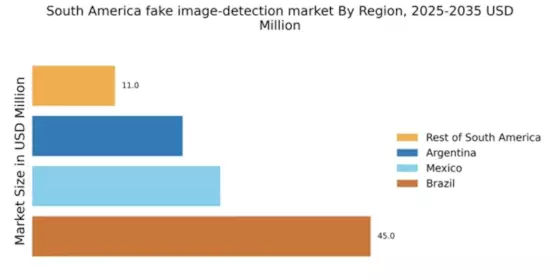The competitive dynamics within the fake image-detection market are characterized by rapid technological advancements and an increasing demand for reliable verification tools. Key growth drivers include the rising prevalence of misinformation and the need for enhanced digital security. Major players such as Adobe (US), Google (US), and NVIDIA (US) are strategically positioned to leverage their technological prowess and extensive resources. Adobe (US) focuses on integrating AI capabilities into its products, enhancing user experience while ensuring authenticity. Google (US) emphasizes partnerships and collaborations to expand its reach, while NVIDIA (US) invests heavily in GPU technology to support advanced image processing capabilities. Collectively, these strategies foster a competitive environment that prioritizes innovation and technological integration.
In terms of business tactics, companies are increasingly localizing their operations to better serve regional markets, optimizing supply chains to enhance efficiency. The market structure appears moderately fragmented, with several key players exerting influence over various segments. This fragmentation allows for niche players to emerge, yet the collective strength of major companies shapes the overall competitive landscape, driving standards and innovation.
In October 2025, Adobe (US) announced the launch of a new suite of AI-driven tools aimed at enhancing image authenticity verification. This strategic move underscores Adobe's commitment to innovation and positions it as a leader in the market. By integrating advanced algorithms, Adobe (US) aims to provide users with robust solutions to combat misinformation, thereby reinforcing its market presence.
In September 2025, Google (US) expanded its partnership with various media organizations to develop a comprehensive framework for detecting manipulated images. This collaboration is significant as it not only enhances Google's capabilities in image verification but also establishes a standard for the industry. Such partnerships are likely to bolster trust in digital content, a critical factor in today’s information landscape.
In August 2025, NVIDIA (US) unveiled a new AI model designed specifically for real-time image analysis, which could revolutionize the way fake images are detected. This development is pivotal, as it allows for immediate verification, catering to the growing demand for instant solutions in a fast-paced digital environment. NVIDIA's focus on real-time processing may set a new benchmark for competitors, emphasizing the importance of speed and accuracy in image detection.
As of November 2025, current trends in the market indicate a strong shift towards digitalization, with AI integration becoming a cornerstone of competitive strategies. Strategic alliances are increasingly shaping the landscape, fostering collaboration that enhances technological capabilities. Looking ahead, competitive differentiation is likely to evolve, moving away from price-based competition towards a focus on innovation, technology, and supply chain reliability. Companies that prioritize these aspects may find themselves better positioned to navigate the complexities of the market.


















Leave a Comment